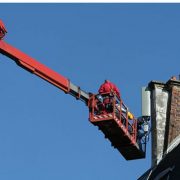Access Equipment and Chimneys
Chimneys, whether domestic or industrial, are notoriously difficult to access, and domestic and industrial chimneys are very different in terms of both access and maintenance. All chimneys need to be maintained, and the maintenance routine is different depending on their size and on what the chimneys are made of: reinforced concrete, steel or brick.
Domestic Chimney Maintenance
Regular maintenance of a domestic chimney includes sweeping, which is best done on the ground, through the fireplace damper. However, especially in brick chimneys, sometimes it is necessary to do a physical inspection, and oftentimes, bricks have to be re-pointed or replaced. The chimney cap and flashings occasionally need repair or renewal, too. Often, a cherry picker hire is just the ticket.
EWPs are faster and cheaper than scaffolding
There are companies that have specially designed scaffolding for chimney work, scaffolding that will conform safely to the slope of the roof. However, using access platforms for chimney work is usually faster, cheaper, and less intrusive than erecting scaffolding. If there is good access, a telescopic boom lift is often appropriate for work on large chimneys.
Demolition of chimneys creates special problems. Usually, domestic chimneys are demolished by hand, with sledgehammers. Without a stable platform, this can be very dangerous. For safety, it is a good idea not to let any rubbish fall to the ground. An elevated platform makes it much easier to transport wreckage safely down, either by raising and lowering the boom or by erecting a temporary chute between the work area and the skip.
Specialised engineers required for industrial chimneys
Industrial chimneys are a science unto themselves, literally. Very well trained engineers and technicians are required for regular maintenance of an industrial chimney. Some of these are huge, over a hundred metres high, and they are often of very large diameter. Much maintenance is high tech, for example, ultrasound is used to test concrete strength; metal fatigue testing is used on joint bolts in steel chimneys; and chemical testing is used to determine if industrial chimneys have reacted with combustion gases. Recently, unmanned aerial drones have been adopted for big chimney inspections, but these are limited in their operation to line-of-sight. This means that inspecting the inside of the chimney is done the old-fashioned way, with steeplejacks on the end of ropes lowered into the chimney. The ropes are connected to electronic winches.
Knuckle booms fitted with hydro demolition lances
If the chimney is low enough, elevated platforms are very useful; usually articulated booms are used because they can reach great heights. There also exist specially equipped knuckle booms that can be fitted with hammers, rock drills and hydro-demolition lances. For very high chimneys, the most common platform is controlled by ropes attached to hydraulic winches. There are specially fitted varieties of these that attach to a rotor that can move around the chimney.
Even with the most sophisticated equipment, chimneys can hold nasty surprises. They may be lined with asbestos, for example. As with most jobs using elevated platforms, specialised training is required.



